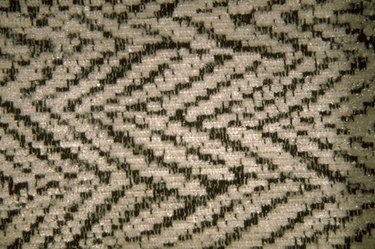Things You'll Need
Suit
Matching fabric threads or pieces from the suit
Extra-fine crochet hook
2 darning needles
Matching thread color
Scissors

Holes happen. Depending on the size and location of a hole, you have a couple of options to salvage your clothing. The first is expensive, and entails taking or sending your suit to one of the few reweavers still working in the U.S. The second option is to tackle the reweaving yourself. Examine the suit and determine how large the hole or tear is that needs to be repaired. If it's a small hole, the technique to use is called French reweaving. If the hole is larger, this type of repair is called piece reweaving or inweaving.
French Reweaving
Step 1
Select several threads from an unobtrusive area of the garment, and thread them through the darning needle. These threads may be collected from the edge of the hem, from an interior pocket or along the edge of an unfinished seam in the jacket, pants or skirt of the suit.
Video of the Day
Step 2
Use the crochet hook to pull all the frayed edges around the hole through to the inside of the garment.
Step 3
Connect the threads you've gathered and, with the darning needle, attach each thread to its corresponding lengthwise frayed thread by making a small loop and pulling the thread taut. Then thread the needle and sew the new longer thread to the other side of the hole. Repeat this until you have all the vertical or lengthwise threads sewn. These lengthwise threads are called the warp.
Step 4
Thread the needle again and weave the thread horizontally through the warp threads, alternating over and under each thread so you get a weave pattern. This is called the weft. As these holes are small, you will probably only have to use one thread unless your garment has a pattern that calls for other colors in the reweave. This method is quite effective with wool or heavier materials, as the repair blends into the suit and is nearly invisible to the naked eye.
Piece Reweaving or Inweaving
Step 1

Cut a piece of cloth from a facing, hem, pocket or interior of a cuff that is slightly larger than the size of the hole being repaired. Note the direction of the pattern, so that you will place it correctly against the hole. For instance, a chevron pattern consists of "V" shapes that often have threads in different colors, while a pinstripe has a vertical stripe in a different color than the surrounding area.
Step 2
Pull the loose threads of the hole to the interior of the garment, using the crochet hook. The purpose of the piece reweaving is to seamlessly interweave the new piece into the tear, so that it appears totally integrated into the suit. Thread the darning needle using thread that closely matches that used in the weave.
Step 3
Attach the lengthwise or warp threads to the piece. Alternating in and out, weave the weft threads through the horizontal portions of the piece. Weaving the weft consists of working over and under in one direction and then turning the needle and weaving in the other direction -- reversing the order so that those pieces that were under are now over, to match the pattern and colors of the piece. You may have to use another needle and match threads accordingly.
Step 4
Match the fabric that was cut from the garment with the weave. Once you've determined the direction of the lengthwise threads, you can then weave the weft threads in the direction of the patch. Use the darning needle, the loose thread and the frayed ends to weave the fabric into the pattern of the suit. You may have to use more than one darning needle to reweave if you have a complex pattern with different colors, however the process remains the same.
Step 5
Sew very small back stitches with matching thread around the rewoven threads on the interior of the garment. Just as the original thread outline of the hole prevented the tear from fraying into a larger hole, these stitches will reinforce the reweaving and are invisible on the exterior of the garment. While this step is optional, it will provide extra reinforcement to the reweaving so you won't have to make repairs again.
Tip
If you are not certain about your skill at interweaving the threads, practice on cloth that is less important than your suit until the skill comes more easily.
Video of the Day